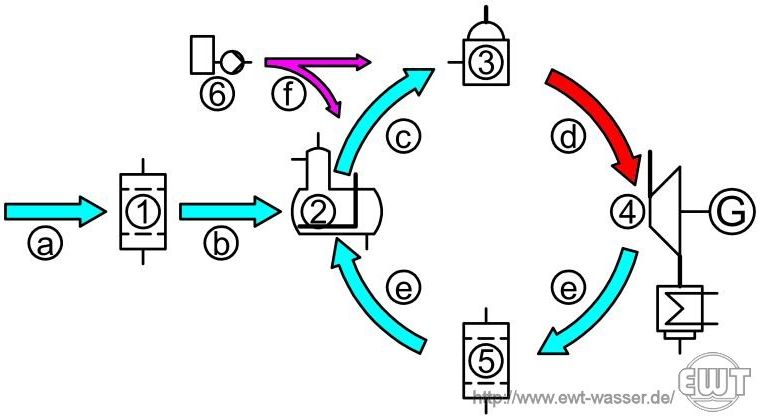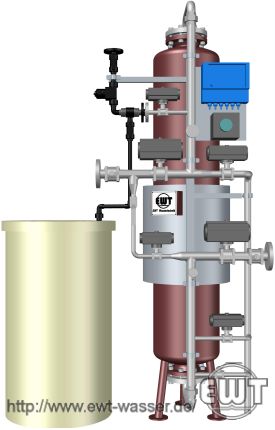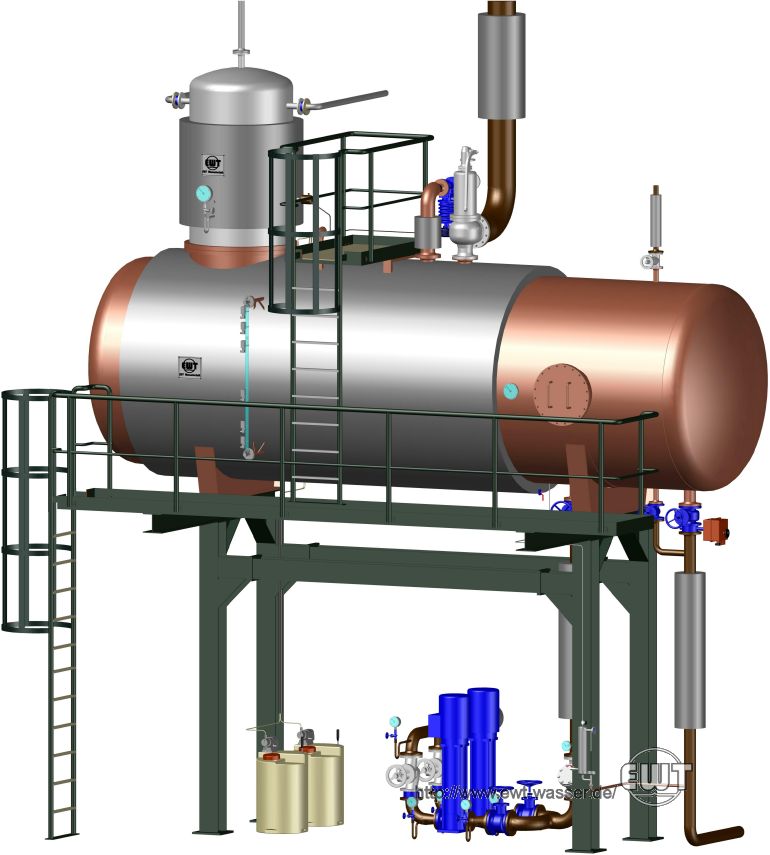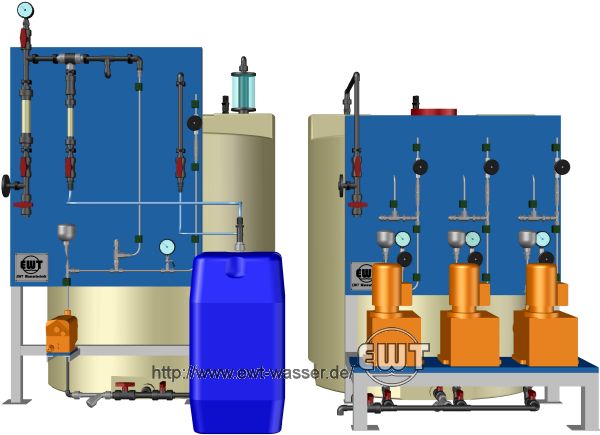

← Home • Applications • Boiler Feed Water ↓ Introduction • Make-up Water Treatment • Condensate Polishing • Deaeration • Chemical Treatment
In order to ensure a safe, legal, and economic operation of a steam boiler, the quality of both the boiler water and boiler feed water must conform to certain →requirements, which depend upon the design and the mode of operation of the steam boiler. Within the European Union, those requirements are defined in certain harmonised European standards (e.g. EN 12952-12, EN 12953-10), and further in codes issued by certain organisations (e.g. VGB, VdTÜV). Natural water and water from municipal supply does without exception not conform to those requirements. Instead, the water needs to be treated by various water treatment processes.
Simplified Flow Diagram of a Water-Steam-Cycle:

1 = make-up water treatment, 2 = bfw tank with deaerator, 3 = steam boiler, 4 = process (e.g. steam turbine), 5 = condensate polishing, 6 = dosing station
a = raw water, b = make-up water, c = boiler feed water, d = main steam, e = condensate, f = chemical conditioning agent
The boiler feed water (c), mainly consisting of make-up water (b) and returning condensate (e), flows from the boiler feed water tank (2) into the steam boiler (3), where evaporation occurs. From there, the main steam (d) flows into the process (4) and condenses. Condensate (e) returning from the process (4) flows into the boiler feed water tank (2), after having been treated in the condensate polishing plant (5) if applicable. Water losses in the water-steam-cycle, for example resulting from boiler blow-down, are replenished by make-up water (b), which has been treated by the make-up water treatment plant (1). That make-up water is produced from raw water (a), which for exmaple may be water from the municipal water supply.
One task of boiler feed water treatment is to reduce the contamination of the water-steam-cycle with foreign substances to allowable levels. Foreign substances may be suspended solids, ionogenic substances, or dissolved gases. Contamination of the boiler feed water (c) and thus of the water-steam-cycle with foreign substances occurs mainly through the make-up water (b). However, condensate-side (e) contamination is also possible, for example due to corrosion processes, condenser leakage, chemical conditioning (f), or process-related reasons. ↓Make-up water treatment (1) and ↓condensate polishing (5) serve mainly for removal of suspended solids and iogenic substances from the make-up water (b) and condensate (e), while ↓deaeration (2) mainly serves for removal of dissolved gases from the boiler feed water (c).
Another task is ↓chemical conditoning of the boiler water and boiler feed water, in order to further minimize corrosion within the water-steam-cycle. To this end, a dosing station (6) is used for injecting chemical conditioning agents (f) into the boiler feed water (c) at suitable locations.
In the now obsolete German code TRD 611, there used to be definitions for different →operating modes, based upon the electrical conductivity of the boiler feed water; those can be roughly translated as "high TDS", "low TDS", and "no TDS". In the latest harmonised European standards, the basically same distinctions are still made, however without defining any corresponding terms. Industrial boilers for generation of process steam usually operate in "high TDS" or "low TDS" mode, while steam boilers for steam turbine plants usually operate in "no TDS" mode. In case of "no TDS" operation, further distinctions based upon the kind of ↓chemical conditoning of the boiler water and boiler feed water are required, for example AVT (all volatile treatment), meaning conditioning of the boiler feed water with volatile alkalising agents only. For each distinct mode of steam boiler operation, there is, with a given steam boiler design and steam boiler operating pressure, a different set of requirements for →boiler feed water and →boiler water quality, thus affecting the choice and design of water treatment processes.
For make-up water treatment, different filtration processes, ion exchange processes, and membrane separation processes are used, depending upon the raw water source and quality as well as the design and →operating mode of the steam boiler plant.
In case of "high TDS" operating mode, a →softening plant for removal of the alkaline earth ions calcium and magnesium from the make-up water is usually used. In case of "low TDS" operating mode, a →reverse osmosis plant for demineralisation of the make-up water is usually used.
In case "no TDS" operating mode, full demineralisation of the make-up water is required, usually by means of →ion exchange or →membrane separation processes. A tpyical process design includes for example an →ion exchange demineralisation plant consisting of a cation exchanger, degasser, anion exchanger, and a →mixed bed polisher.
Depending upon the source and quality of the raw water, further pre-treatment steps may be required, for example a →sand filter plant for removal of iron and manganese from well water, or in case of surface water a →multi-media filter plant or →ultrafiltration plant with an upstream →dosing plant for flocculation.

Membrane separation plant for make-up water demineralisation, two lines, process sequence: Cartridge filter → reverse osmosis → membrane degasser → EDI → mixed bed polisher.

Condensate softener for an industrial plant.
For softening and demineralisation of condensate, usually ion exchange processes are used rather than membrane processes, as the former can be designed for significantly higher process temperatures. The selection and design of the treatment process depends upon both the expected quality of the raw condensate, and the quality requirements as defined by the →operating mode of the steam boiler plant.
In case of small to medium-sized industrial plants, a condensate polishing plant is often only installed on a by need basis, for example in case of contaminated process condensate.
For "high TDS" and "low TDS" operating mode, a →cartridge filter for removal of suspended solids, e.g. rust particles, is in many cases sufficient. In case of condensate contamination with water from external sources, a temperature-resistant →softening plant is used for removal of calcium and magnesium ions. Plants of this kind are suitable for hot water applications with an operating temperature of 100 °C and more.
In case of "no TDS" operating mode, demineralisation of the condensate will be required based upon the kind of ↓chemical conditioning, or also in case of any contamination by process condensate (e.g. in the pulp and paper industries) or condenser leakages. Usually, a →mixed bed polisher is used for demineralisation, as required with an additional upstream cation exchanger or →cation and anion exchanger plant. The allowable operating temperature is limited by the temperature resistance of the anion exchange resins. Usually, plants of this kind are thus operated with a condensate temperature between 50 °C and 60 °C. To this end, a heat transfer system for upstream cooling and downstream re-heating of the condensate is used. For removal of suspended solids, e.g. rust particles, an upstream →cartridge filter is used.
Further treatment processes may be required for certain special applications, for example a →granular activated carbon filter for oil removal, or an ion exchanger with a special regeneration process for removal of copper or other heavy metals.
For deaeration of boiler feed water, a thermal deaerator is usually used. In Europe, this thermal deaerator is usually designed as either a →sieve tray deaerator in case of small to medium-sized steam generation plants (steam mass flow ≤ 250 t/h ≈ 70 kg/s), or as a spray deaerator in case of larger steam generation plants (steam mass flow > 300 t/h ≈ 80 kg/s). Other deaeration processes are only used very rarely, for example →membrane degassing or exclusively ↓chemical oxygen scavenging in case of very small plants.
In larger steam turbine plants, sometimes no separate deaerator is used at all. Instead, partial deaeration of the condensate then occurs within the vacuum stage of the condenser. This is mode of operation is usually requires ↓chemical conditioning by oxygenated treatment (OT).

Thermal deaeration plant for a process steam generator: Sieve tray deaerator, boiler feed water tank, valves and instrumentation, sample cooler, compact dosing system, boiler feed water pumps.
For chemical conditioning of the water-steam-cycle, certain chemical agents are dosed into the boiler feed water by a →dosing system. These chemical agents may for example serve for adjusting the pH-value and alkalinity, as oxygen scavenger, as hardness inhibitor, or as film-former. Depending upon the →operating mode of the steam boiler plant among other things, different chemical treatment programs can be applied.

Dosing system for AVT/phosphate-conditioning of boiler feed water and boiler water.
Chemical agents can be separated into volatile and non-volatile agents. Volatile agents mainly serve for conditoning of boiler feed water and condensate, while non-volatile agents serve for conditioning of the boiler water. However, this separation is not equally strict for all applications and operating conditions. Especially in case of steam boilers operating with low boiler water cycles of concentraiton, for example in case of "high TDS" operating mode, the boiler feed water can often be sufficiently conditioned by using non-volatile agents only; the use of volatile agents is often omitted in this case. Certain non-volatile or less volatile agents split into more volatile substances when subject to high pressure and temperature and pressure, for example the less volatile hydrazine (N2H4) into the more volatile ammonia (NH3) and nitrogen (N2).
In case of "high TDS" and "low TDS" operating mode, the pH-conditioning of the boiler water is achieved by dosing of for example trisodium phosphate (Na3PO4) into the boiler feed water. In case of low to medium operating pressure, an oxygen scavenger is usually dosed as well, for example sodium sulphite (Na2SO3). In case of high boiler water cycles of concentration, or in case of condensate-side corrosion problems, volatile agents are used additionally, for example ammonia solution (NH3) for pH-conditioning. For plants of this kind, chemical mixtures sold under fantasy names are also often used; in some cases with questionable actual usefulness and economic feasibility.
In case of "no TDS" operating mode, small to medium-size plants are usually operated in alkaline mode, meaning conditioning of the boiler feed water by dosing of volatile agents, for example ammonia solution (NH3), and conditioning of the boiler water by dosing of non-volatile agents, for example trisodium phosphate (Na3PO4) or in some cases sodium hydroxide (NaOH). A chemical oxygen scavenger is usually not required for plants of this kind.
Larger steam turbine plants, especially those equipped with once-through boilers, are often operated with neutral or OT (oxygenated treatment) chemical conditioning, instead of the alkaline conditioning as described above. This operating mode requires conditioning of the boiler feed water with oxidizing agents such as hydrogen peroxide or oxygen, while at the same time reducing or completely omitting alkaline conditioning as described above. This results in stricter requirements regarding the boiler feed water and condensate quality, however offers certain advantages when considering all components of the water-steam-cycle.
2018-05-05 • water treatment made in Germany • Company Information • Privacy